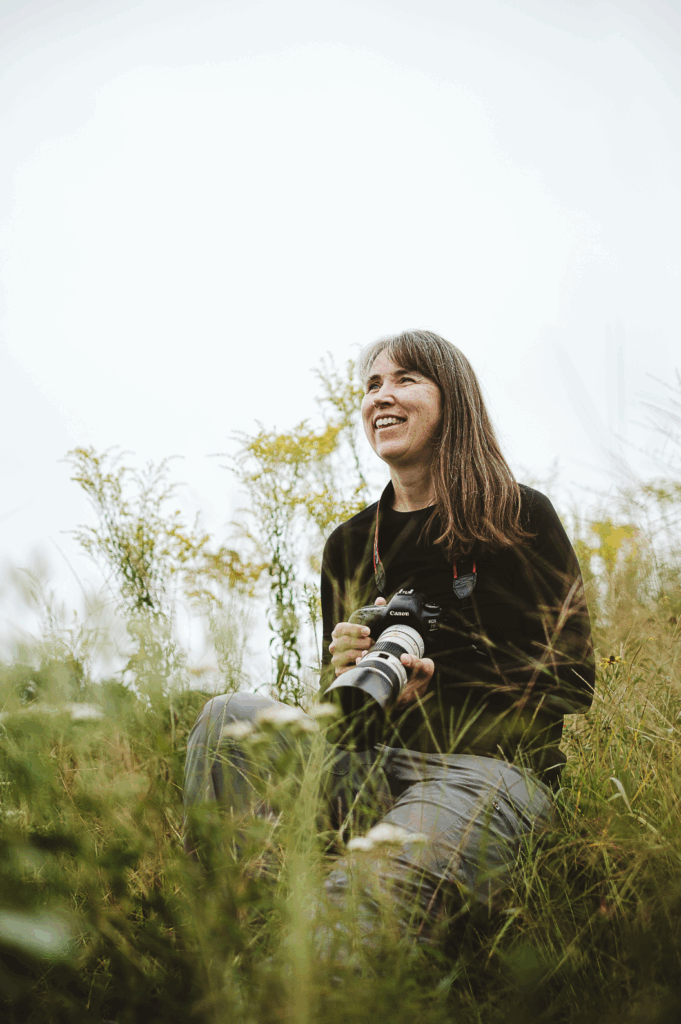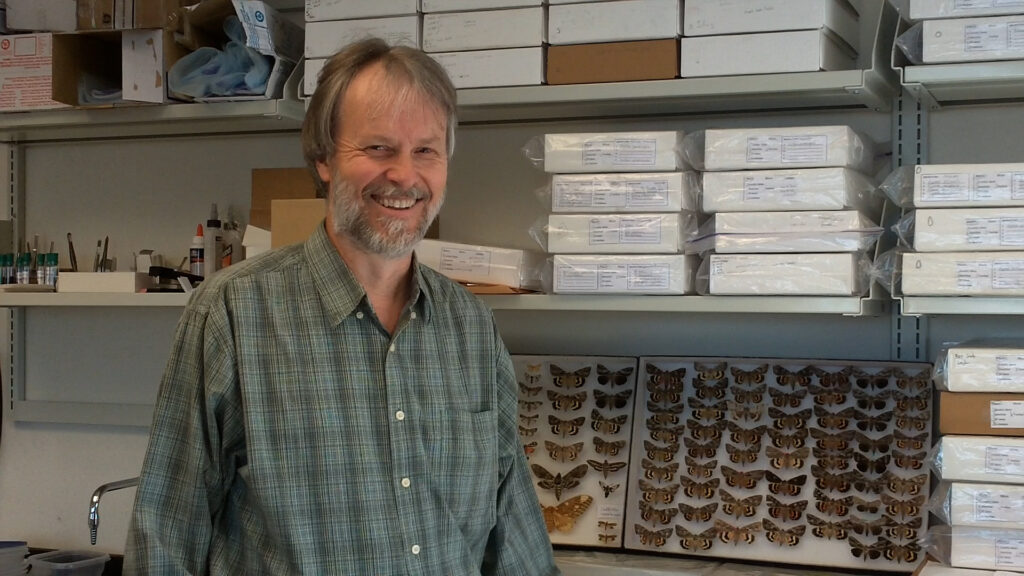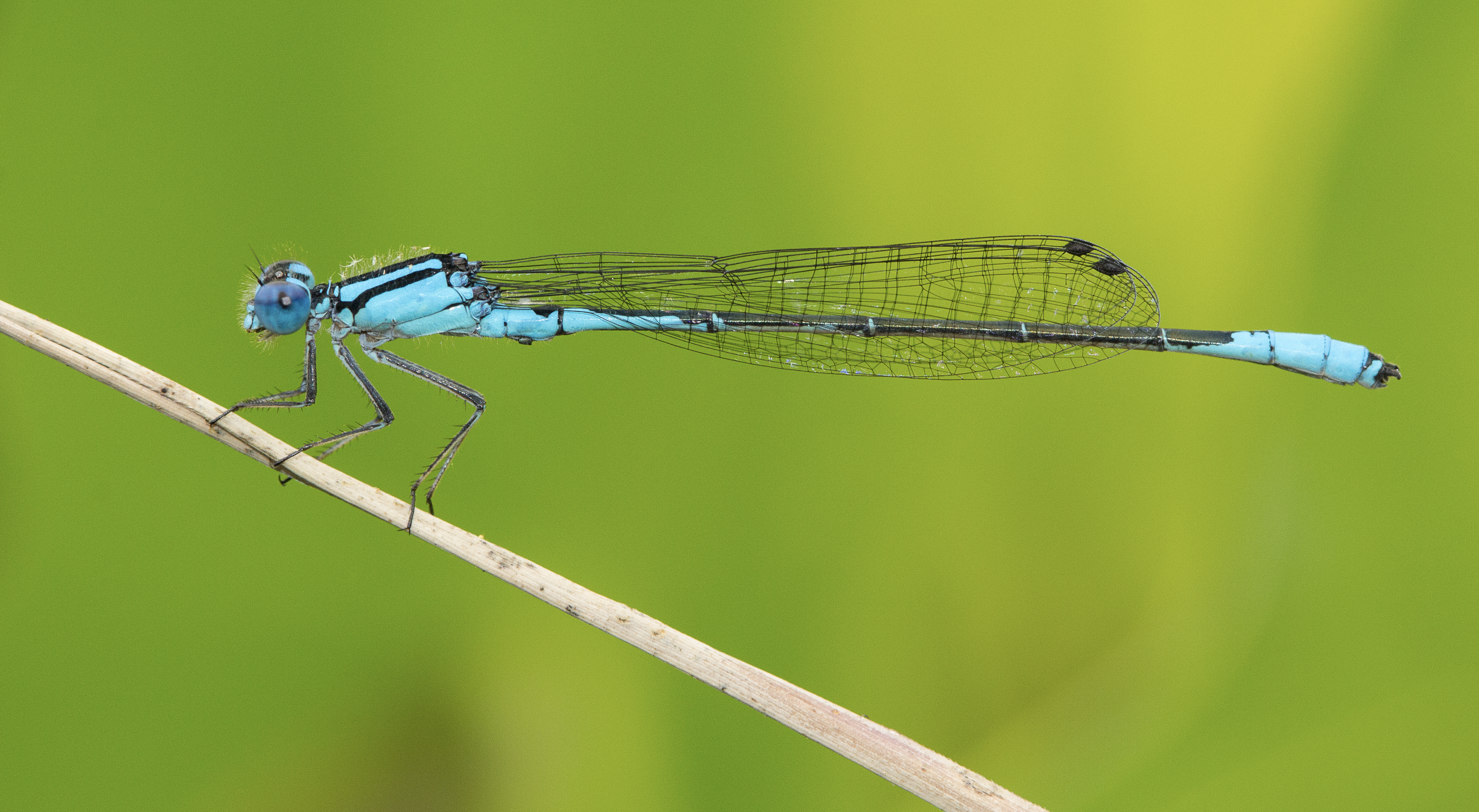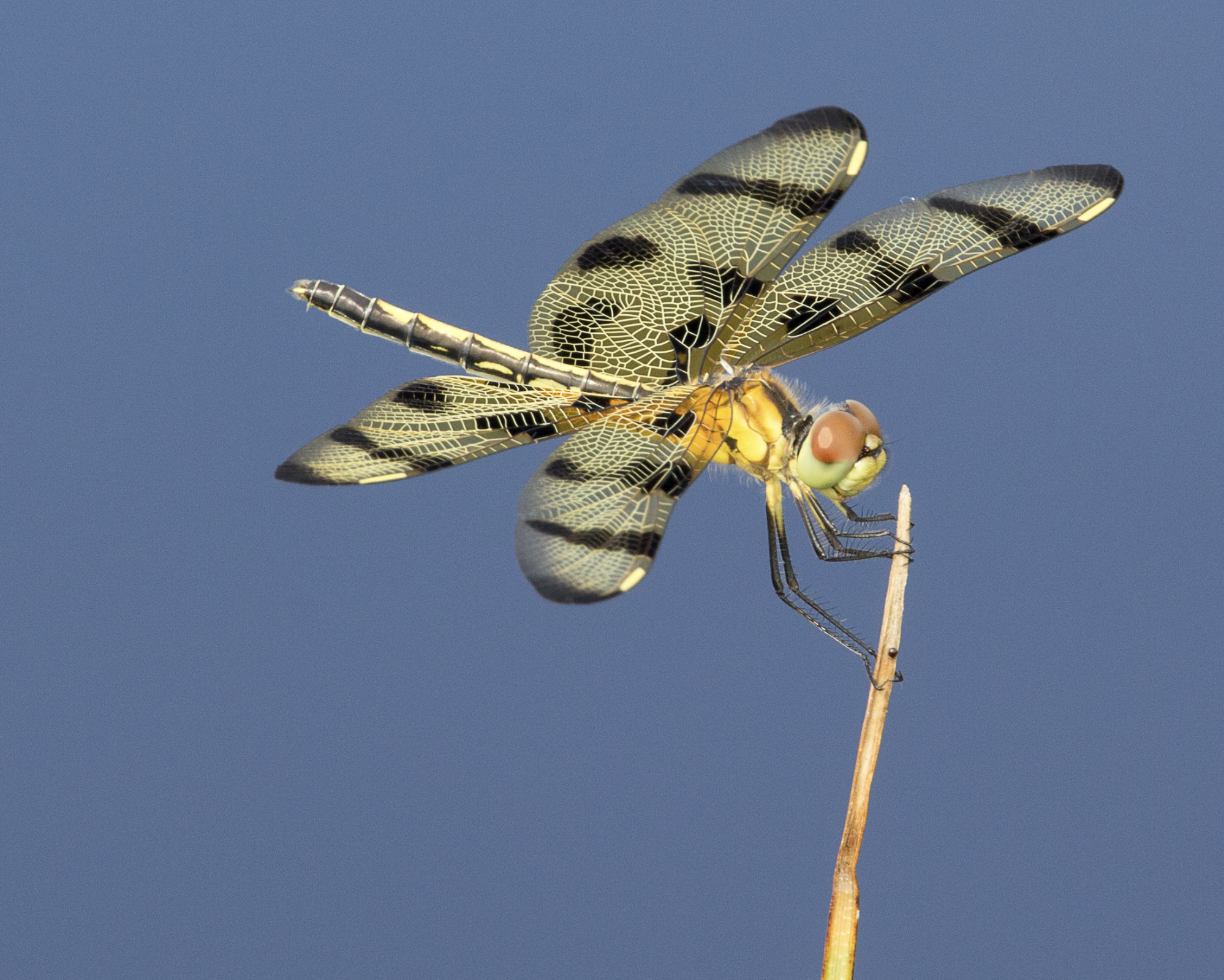How does a mathematician turn into an odonatologist? (And what the heck is an odonatologist?) Emily Luebke can tell you all about it.
A love of the outdoors led math major Luebke to become a photographer of wildlife, especially insects. That led her to a fascination with dragonflies (in science terms, order Odonata), which led to a career in ecology and an avocation as a citizen scientist—not necessarily what you’d expect from a numbers person and competitive ultimate frisbee player (more on that later).
Luebke grew up in semi-rural Albemarle County. “I was outdoors a lot, and played a lot of sports,” she recalls. She went Carleton College in Minnesota, in part because the school had an 800-acre arboretum next to campus, where she could lose the tensions of academia in the woods. After earning a math degree, Luebke pursued a doctorate in operations research (advanced mathematics) at UNC Chapel Hill; she also met her husband David while they were both playing on Darkside, the school’s ultimate frisbee team. Jobs at UVA brought the couple back to Charlottesville, where Luebke chose to “retire” to raise their three children (and yes, help start an ultimate frisbee club team here).

It was on a family trip to Canada that Luebke developed a new direction. “I liked nature photography,” she recalls, “and I was trying to take a picture of this beautiful rose, but I was getting frustrated by my point-and-shoot camera. It just wasn’t capturing what I could see.” Her husband noticed her frustration, and bought her an SLR camera. Luebke began taking photography classes with well-known nature photographer Victoria Dye at PVCC, and then with other teachers as well.
From her first classes in 2009, Luebke says she became more and more engrossed in nature photography. Once she had a macro lens, she could get really close-in shots of the wildlife and plants she found fascinating. While she has done some landscape photography, it’s the incredible detail and intricate beauty of small things that most often draws her attention. “Photography makes you slow down,” she says, “and take the time to get the image right.”
The next evolutionary step came in 2013 in Sandbridge, Virginia, where the family often went on vacation. “I was still new into photography,” Luebke recalls, “and I decided to get up early, before the kids got up, and go to the Back Bay National Wildlife Refuge.” In the refuge’s wetlands, Luebke found herself in the midst of a massive emergence of dragonflies. (These insects come out of their final larval stage in a process that takes a few hours; they have to develop their flying skills, and then start searching for food—and mates.) “I started getting close to these insects, and they were amazing—the colors, the patterns.”
Inspired, Luebke decided she had to learn more about dragonflies. In 2014, she enrolled in training to qualify as a master naturalist, a national program that’s sponsored in Virginia by state environmental agencies, and administered through the Virginia Cooperative Extension program run out of Virginia Tech and Virginia State University.
The master naturalist training is a general introduction to natural history and ecology. Luebke found it helpful, but her real interest was dragonflies, so she bought a guidebook authored by Odonata expert Dennis Paulson. “I started with trying to learn the names [of the local species],” she says, but as she became more knowledgeable she also started being more intrigued. “I found what I thought was a lilypad forktail, but my book said they weren’t found in Albemarle County.”
By now, Luebke was deep into the dragonfly world. She found a website called Odonata Central, where devotees can swap information, share sightings and photographs, and delve into dragonfly lore. But she still couldn’t find an answer to her question: Was it possible that what she was seeing in Albemarle County was in fact a lilypad forktail?

In September 2014, Luebke decided to go to an expert: Steve Roble, senior zoologist with the Virginia Department of Conservation and Recreation’s Virginia Natural Heritage Program. She emailed Roble with her lilypad forktail question, and he put her in touch with Albemarle County amateur odonatologist Jim Childress. Childress, another person with a totally unrelated degree and career but a personal fascination with dragonflies, had been collecting specimens around the county for years. And yes, he had confirmed the presence of the lilypad forktail.
Luebke teamed with Childress on identifying the varieties of Odonata they were finding locally. “When we started, there were 95 species identified as being found here in Albemarle County,” she says. “Now we’re up to 114—77 dragonflies and 37 damselflies.”
Surprisingly, their work is the closest thing available as an official list of central Virginia Odonata. Roble explains, “My agency [DCR’s Virginia Natural Heritage Program] maintains records of rare and uncommon plants and animals, but not common species. The Virginia Department of Wildlife Resources attempts to maintain records of all vertebrate animals and some invertebrates, primarily mussels, snails, and crayfish. [But] no agency or private group keeps track of all of the many other invertebrate groups such as insects, spiders, millipedes, etc.”
Why does it matter how many Odonata species we have, or whether we are losing any? According to Roble, “Among other things, that information can help identify the types of wetland habitats that occur in the county and if some are rare or unusual and perhaps worthy of protection—some dragonfly and damselfly species have very specific habitat requirements, whereas others are more wetland habitat generalists. The river and stream species can help show which habitats are in the best, cleanest condition. Changes in abundance or species composition of dragonfly and damselfly populations and communities over time can perhaps be linked to changing conditions such as habitat degradation (or alteration) and climate warming.”
In 2015, Devin Floyd, co-founder and director of the Center for Urban Habitats (now the Piedmont Discovery Center) contacted Childress about conducting a dragonfly/damselfly survey at The Quarry Gardens. Floyd’s group was working on the development of the site, centered around two reclaimed soapstone quarries near Schuyler, which now includes miles of walking trails, more than 40 galleries of diverse native plant communities, educational facilities with a classroom and research lab, and a visitor center with exhibits on flora, fauna, and the soapstone industry in central Virginia.
Childress asked Luebke to help him on the survey, using her photography skills. A year later, after the survey was complete, they continued working with Floyd’s group on biological assessments across the site. When Virginia Living magazine did an article on the opening of The Quarry Gardens in 2017, Luebke’s photographs were featured.
Luebke has been working with the Piedmont Discovery Center ever since. Now a senior field technician and wildlife photographer, Luebke does “plot work” projects, “a completely in-depth dive to define the plant community on a selected area of habitat,” she says. This means documenting all plant species at all levels on the site from treetop to soil, including physiographic information like soil, surface, slope, aspect, etc. Whether for public lands or private clients, the goal is a complete inventory of what’s present in order to help restore, protect, and manage the resources there.

“Emily is a very detail-oriented person,” says Floyd. “Good photography is really about seeing, and noticing something that is both artful, likely overlooked, and also inspiring when shared. Her ability to notice that, and then capture it, is amazing. So her work is now utilized in two ways: She joins the field crew to do biological assessment, and while there she captures photographs of key species, habitat views, and staff working shots. [Her photos] are also often featured in our biological survey reports, online galleries, other publications, and in exhibitions of our work.”
Luebke has been doing more and more work with PDC, but that doesn’t mean she has given up her passion for Odonata. She continues to seek out dragonflies and damselflies in her walks around the county. Most of her photographic work now, she says, is documenting dragonflies. “My family knows, if we’re out on a hike, that Mom might get distracted if there’s dragonflies around.”
How does one capture such an ephemeral creature? “It helps to know their habits,” Luebke says. “Some dragonfly species are perchers, so it’s easier to get them standing still. Others are hawkers—they fly up and back, but usually in a pattern so you can track them. It’s all about being patient, being observant—and being willing to look kind of odd.” But staring intently at branches with a macro lens or plunging through thickets in pursuit of these jewel-hued aviators doesn’t seem to stand in her way.
Luebke also does a lot of public education. Using both her knowledge and her photographs, she has done presentations for Ivy Creek Natural Area, the local Sierra Club chapter, and master naturalist chapters in the area. Next up is a full-day symposium at The Quarry Gardens on August 23, with Childress and Ethan Tolman, a postdoctoral researcher at Virginia Tech, as speakers. The event will also include a trail walk and an off-site field trip to document sightings for the Dragonfly Society of the Americas’ annual Odolympics.
A few years ago, Luebke joined Childress on his ongoing project to document the Odonata species in Shenandoah National Park. The park’s records were minimal, confirming fewer than 10 species—after all, the park covers mountainous terrain over eight counties with only a few staff biologists. Working with SNP staff, Childress got a permit to catch (whether to catch-and-release or collect) and document species in the park. Luebke says they now have records on 61 species, and are still looking.
Chasing dragonflies is a long way from advanced mathematics. But the “amateur” work that Luebke and others are doing makes an important contribution, and one that would be impossible to achieve with the limited resources of government agencies and academic institutions.
“Emily is part of an army of highly skilled individuals that are very reliable contributors to science and conservation,” says Floyd. “Citizen science and volunteer efforts are such an important part of the conservation movement, and having knowledgeable and skilled people leading the way is [essential]. She is an example of how citizen science should function, and she brings tremendous added benefit to that work through her photography. Her art inspires others to get involved, and [that’s] critical for all scientific and conservation efforts if we are to inspire the general public to care and rise up to take the action needed.”
Odonata data
For those of us who aren’t entomologists, the order Odonata covers both dragonflies and damselflies—large predatory flying insects with transparent wings. Dragonflies are usually bigger and have large compound eyes set close together; at rest, their wings spread up or out. Damselflies are slender, with eyes placed apart; at rest, their wings are folded together along the body. As adults, both are insectivores, specialized for hunting on the wing, with legs designed to grab prey. (No, dragonflies and damselflies don’t bite humans.)
While they can range through various habitats, dragonflies and damselflies need water or aquatic plants to lay their eggs. The developing insects go through several stages of aquatic or semi-aquatic larvae, called nymphs, and depending on the species, the larval stage can last months or years. Once they emerge as adults, however, damselflies only live for a few weeks and dragonflies for maybe a couple months—long enough to mate and lay eggs.
Odonata are most common and varied in the tropics, but can be found as far north as the boreal forests of Europe, northern Asia, and North America. In many Asian cultures, dragonflies are considered beneficial and even auspicious; in Europe, however, they have earned nicknames like horse stinger and devil’s darning needle. The only continent without dragonflies is Antarctica.
Fossils of Odonata ancestors have been found in the late Carboniferous age, making them one of the earliest forms of winged insects. One prehistoric dragonfly had a wingspan of up to 27 inches, while today the largest living dragonfly is the Central American helicopter dragonfly, with a wingspan of 7.5 inches.






